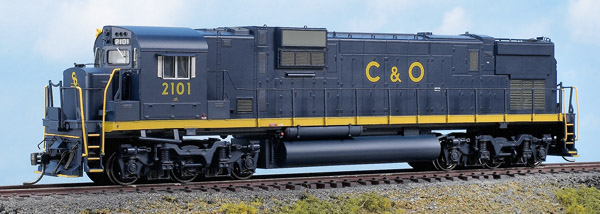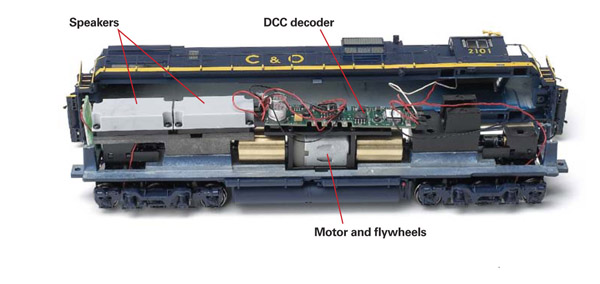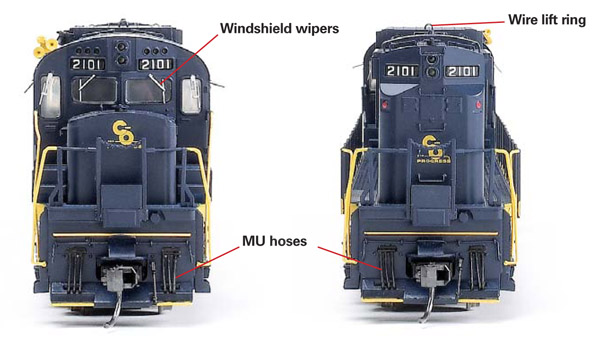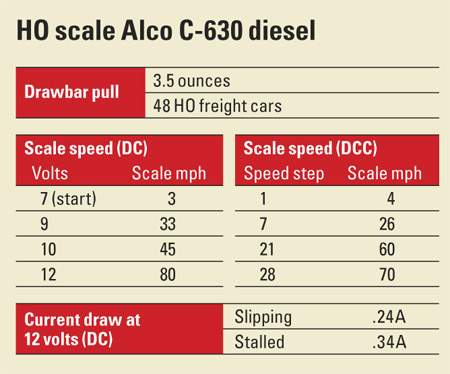Prototype. Between 1965 and 1969 Alco built 133 C-630s for railroads in the United States and Canada. The C-630 had a 3,000-hp 16-cylinder Alco 251E diesel engine. Production of the C-630 overlapped with the production of the 2,800-hp C-628 and the 3,600-hp C-636. The C-630 looked a lot like a C-628. The main spotting feature of the C-630 is the aftercooler that projects upward behind the air intake on top of the hood.
The Chesapeake & Ohio Ry. received its four C-630s in 1967 and numbered them 2100 to 2103. The Chessie sold three of the locomotives to a western Australian railroad in 1974.
The other dimensions of the model match drawings of an early production C-630 printed in the 1966 Car and Locomotive Cyclopedia of American Practice (Simmons-Boardman).
Paint coverage on the model is smooth and even. The yellow lettering is opaque. Even the tiny warning stencils are legible under magnification.
After unscrewing the coupler boxes, I carefully lifted the body shell off the die-cast metal frame. The motor and flywheels are mounted in the center of the frame. The SoundTraxx DCC decoder is attached to the frame above the motor. Two oval speakers in plastic enclosures are mounted facedown.
Performance. I tested the model in our workshop with an MRC Tech 4 DC power pack and an NCE Powercab DCC system. The Alco accelerated smoothly during both DC and DCC speed tests. During the DC speed test, the diesel reached 80 scale mph, and during the DCC test it reached 70 scale mph. Both speeds were possible with prototype C-630 gear ratios.
The starting speed on both the DC and DCC test track was 3 scale mph. After I set the model’s decoder to 128 speed steps, it crept along smoothly at 1 scale mph in speed step 1 when I ran it with our DCC system.
I also ran the Bowser model on the Model Railroader club layout, the Milwaukee Racine & Troy, using a CVP EasyDCC system. According to our drawbar pull tests, the diesel can pull 48 HO scale freight cars on straight and level track. During climbing tests on the MR&T, the Alco easily hauled 20 coal gondolas up a 1.5 percent grade and pulled 16 gondolas up a 3 percent grade without slipping.
The decoder features many programmable configuration variables (CVs) that let you fine-tune locomotive performance and sound effects with a DCC system. You can adjust the decoder’s seven-band equalizer, choose between six different air horns, and adjust the locomotive’s speed table. A user’s manual is available at www.soundtraxx.com.
The delay between the engine rpms and the movement of the locomotive is adjustable using CV116. You can also set CV116 to 0 and use function keys 9 and 10 to manually notch the engine rpms independently of the locomotive speed.
The decoder is dual mode, but the sound effects are limited on a DC layout. The model’s sounds and lights activate at 6.5 volts. As I advanced the track voltage the diesel rpms increased and the model started moving. When I flipped the direction button a grade-crossing signal sounded. I found this feature annoying, and it can be turned off. However this programming requires a DCC system.
Especially with a DCC system, the Alco C-630 from Bowser is a fun locomotive to run. The newly tooled Hi-Ad trucks and roadname-specific details make this HO diesel a standout model.
Manufacturer
Bowser
P.O. Box 322
Montoursville, PA 17754
www.bowser-trains.com
Road names (two road numbers each): Chesapeake & Ohio, Conrail, Pennsylvania RR, Reading Co., Union Pacific. C&O and RDG have Hi-Ad trucks. PRR and UP have Tri-Mount trucks. Conrail is available with either type of truck.
Era: 1965 to early 1980s
Features
- All-wheel drive and electrical pickup
- Chemically blackened metal RP-25 contour wheels in gauge
- Five-pole skew-wound motor with dual brass flywheels
- Kadee knuckle couplers at correct height
- Light-emitting diode headlights
- Minimum radius: 22″
- SoundTraxx DCC sound decoder (DCC sound version only)
- Weight: 1 pound 3 ounces

















